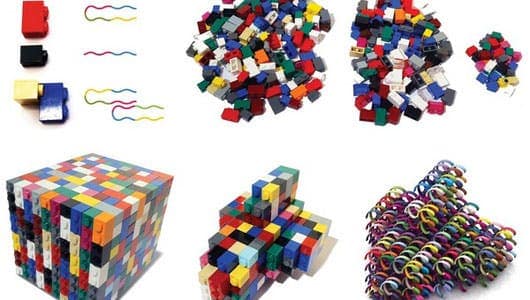
In a breakthrough for nanotechnology, researchers at the Harvard’s Wyss Institute have found the right mix of chemistry and molecular programming to trick DNA strands to fit together perfectly, just like Lego bricks, and thus form various objects and shapes, all based on the scientists’ software design. Thus, a myriad of objects made out of DNA were created in the Harvard labs, from a space shuttle, to letters of the alphabet, to honeycombs. The scientists believe these resulting tiny DNA-based structures could serve a great purpose in medical research and treatment, as well as electronic devices.
The scientists’ method relies on synthetic strands of DNA that take in just 32 nucleotides, or molecular bits of genetic code. These can bind to as many as four neighboring strands or bricks. Thus, two bricks connect to one another at a 90-degree angle to form a 3D shape, just like a pair of two-stud Lego bricks. Each individual brick is coded in such a way that they self-assemble in a desired 3-D shape. What’s fantastic is that this method allows for intricate shapes to built on an extremely tiny scale opening up a slew of applications. For instance, a cube built up from 1,000 such bricks (10 by 10 by 10) measures just 25 nanometers in width – thousands of times smaller than the width of a human hair!
“Once we know how to compile the correct code of complex shapes and add it to the synthetic DNA strands, everything else is simple and natural,” said Yonggang Ke, a chemist at Harvard University. “Those DNA strands are like smart Lego bricks that know exactly where to go by themselves.”
The research is based on previous work from the same Wyss lab when the scientists used DNA to build 2D shapes. The 3-D assembly was made possible by using the exact right combinations of nucleotides (adenosine, thymine, cytosine and guanine) in the synthesized strands, so that the DNA’s base pair molecules bind to one another in a desired fashion. The process takes a while though. One shape resembling a cube took 72 hours for self-assembly.
Playing with DNA
So far, 102 different 3-D shapes were created using a 1,000-brick template.

This isn’t the first time 3-D molecular assembly from DNA has been made though. Previously, scientists used to rely on a method called the Origami method, which works by folding a single DNA strand into a desired shape. The technique is rather obtuse, however, and not nearly as effective as the “lego” method from Harvard. Origami requires custom “staple” DNA strands to fold the main, “scaffold” strand into a desired 3-D shape. In contrast, the lego method makes for a much easier assembly.
“This is a simple, versatile and robust method,” the study’s senior author, Peng Yin, said in a news release.
Still, considering the required applications both Origami and Lego methods can now be used by scientists, improving their toolbox. The scientists are confident that a range of new applications might be possible in molecular assembly, like complex nanostructures that could be used as smart drug delivery devices inside the human body.
“Personally, I am enthusiastic about the potential application of DNA nanotechnology to make intelligent drug-delivery vehicles and to arrange and wire molecular electronic components,” said Kurt Gothelf, director of the Center for DNA Nanotechnology at Aarhus University in Denmark.
Findings were detailed in the journal Science.






